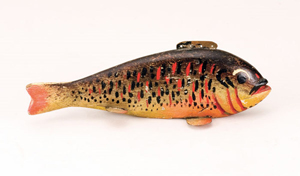
MANISTIQUE, Mich. (AP) – Carving fish decoys started out as just a hobby for Manistique resident Walter Welch, but it’s turned out to be much more than that. Welch’s pastime brings peace and tranquility to his life and allows him to connect with others.
Welch, 74, has been seriously making decoys for about 25 years, although he experimented with them long before that. He was 12 when he made his very first decoy.
“When I was a kid, me and my brother used to go spearing on the river and we used to make our own fish decoys,” he said. “Sometimes you’d get lucky and make a good one, and sometimes it wouldn’t turn out that great.”
Making decoys requires precision and care. Welch uses a band saw to cut a piece of basswood, which he said is a less grainy and porous type of wood. He then carves the wood into the desired shape and sands it down until it’s completely smooth.
He attaches fins cut from aluminum, then pours lead into the bottom of the fish. The amount of lead has to be just so, since the weight of the decoy and the way it floats depend on it. Welch said his grandson helps him test the decoys to make sure they float the right way.
“When you put it in the water, it has to lay flat,” said Welch, as he demonstrates by dangling a decoy in a plastic tub of water. The decoy dips just slightly, up and down, under the water, just like a fish when it’s swimming.
After it’s finished, Welch carves his trademark in to the bottom of the decoy: the letters W.W.
Welch’s decoys are used in darkhouse spearfishing, a type of ice fishing. Darkhouse fishing involves a spear and a fishing line tethered to a decoy. The decoy is dangled in the water to lure fish under a large hole cut in the ice.
Some buy Welch’s decoys just for decoration, but others buy them because they work. Welch said he’s had many satisfied customers who have shared their success stories, telling him they’ve caught more pike with his decoy than with any other.
“I guarantee all my decoys,” Welch said. “If it doesn’t work, I’ll give you your money back. I’ve never gotten one back and I’ve never had a complaint.”
Welch began selling his decoys when his friends and family, who were impressed with his work, encouraged him to make a business out of it. Soon, Welch and his wife Darlene began attending craft shows, selling hundreds of decoys. In a year, Welch would make up to 400 of them.
One of his decoys was even featured in a book: The Modern Fishing Lure Collectibles, which also told a little bit about Welch himself. Increasingly, people began asking about Welch’s decoys, and he and Darlene started selling them on the Internet – a successful but short-lived endeavor.
“It got to be a hassle,” Welch said. “I just enjoy making them. I don’t give a doggone if we make a dollar. I love going to craft shows and talking to so many different people. People don’t always buy my fish, but they like to ask how I make them and I enjoy telling them all about it.’
“In the wintertime, I’ll sit down and just carve a little bit while Darlene cuts the fins out. We work together a lot. It’s so much fun. I love it.”
___
Information from: Daily Press, http://www.dailypress.net
Copyright 2009 Associated Press. All rights reserved. This material may not be published, broadcast, rewritten, or redistributed.
AP-CS-08-31-09 1134EDT

